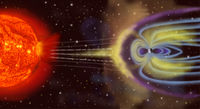
Photo from wikipedia
Abstract A period of minimum magnetic solar activity (such as June 2019) favors the observation of rare solar transient events, which would otherwise be lost in the magnetic vortex during… Click to show full abstract
Abstract A period of minimum magnetic solar activity (such as June 2019) favors the observation of rare solar transient events, which would otherwise be lost in the magnetic vortex during a period of maximum solar activity, In this paper, we show that the most plausible explanation for the origin of an unexpected geomagnetic storm on June 8, 2019, is a small CME, ejected at low speed into a broad tube of an HCS on June 3, 2019, from an active region on the backside of the sun, and only detected by the STEREO Ahead Cor2 probe. The magnetic entrapment of the flux-rope and the ejecta bulk, within the co-rotating HCS (already observed with other small slow CMEs), may be responsible for the large longitudinal deflection of this CME. Several remote observations, from the SECCHI and IMPACT instruments onboard STEREO-A, as well as the predictions of several heliospheric models, favor this scenerio. We report the details of these observations.
Journal Title: Planetary and Space Science
Year Published: 2020
Link to full text (if available)
Share on Social Media: Sign Up to like & get
recommendations!